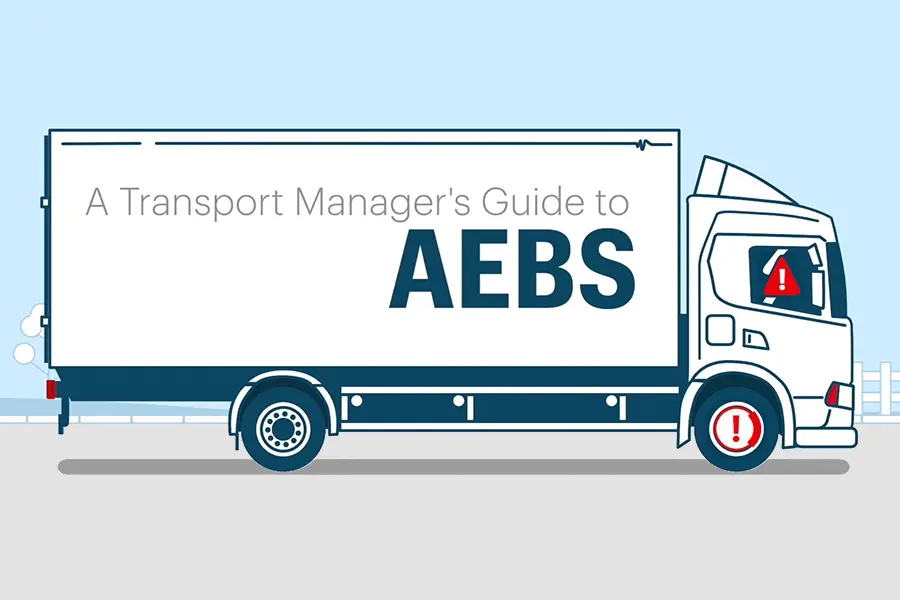Stop Right There! Get To Know The Life-Saving Kit On Your Hgv

18th February 2022
STOP RIGHT THERE! GET TO KNOW THE LIFE-SAVING KIT ON YOUR HGV
Advanced Emergency Braking Systems (AEBS) have been fitted as standard to most new HGVs sold in the UK since 2015. Drivers and operators of HGVs need to understand how it works, what it does and why it’s vital, according to Driving for Better Business, which has launched online guidance on the life-saving technology in collaboration with Thatcham Research.
AEBS, also referred to as autonomous and automatic braking systems, activates the brakes when a potential collision is detected and is highly effective in stopping or minimising the severity of a crash where the driver has failed to react.
It operates in three stages, each activating only if the driver has failed to act and a crash looks likely:
- audio-visual warning on the dashboard if the system spots that the truck could potentially collide with traffic in front
- a short, sharp application of the brakes to grab the driver’s attention if it seems a collision remains likely and the driver has failed to respond with either a steering or braking input. The system also charges the braking system in readiness for full application
- if a collision is still imminent, the brakes are applied using the full force of the system – braking harder than the driver would be able to do on their own, bringing the vehicle to a halt or, if that is not possible, significantly reducing impact speed.
“There are two main types of AEBS,” says Simon Turner, Campaign Manager for Driving for Better Business. “All have RADAR looking far ahead, but the more sophisticated systems also feature forward-facing cameras to provide additional input into the system to ‘see’ road markings and signs. There are, however, limitations which drivers and operators need to understand to ensure they maximise the safety benefits of this technology. For example, if the truck’s speed is too high, the system might not be able to bring the vehicle to full stop but the impact should still be less severe. The systems are only designed to avoid collisions with vehicles directly in front of the truck so a vehicle that is partially in the truck’s path – say a broken-down car at the side of the road, half on and half off the carriageway, may not be ‘seen’ by the system. We’ve just produced a simple, short animation to explain all these points which Transport Managers can download and share with their drivers.”
Matthew Avery, Chief Research Strategy Officer at Thatcham Research said:
“We are really pleased to be launching this guidance for HGV drivers. AEBS is a crucial safety system, and we need to raise awareness of the life-saving benefits the technology can bring, not only to HGV drivers but other road users too. Heavy trucks contribute to a higher collision severity leading to a disproportionate amount of casualties in crashes involving heavy vehicles. AEBS plays a very important role in road safety especially with the recent changes made to the highway code and the increased level of responsibility HGV drivers face in a collision.”
Roads Minister Baroness Vere said:
“I’m grateful to Driving for Better Business for producing this informative guidance. I would urge all HGV drivers and operators to learn more about and use this innovative technology, which could potentially be life-saving on the road.”
Drivers and operators can find out all they need to know for safe use of AEBS via the Driving for Better Business website, which includes a short animation, a PDF factsheet and poster for staff noticeboards. The resources cover:
- System capabilities and limitations
- Tips for drivers
- Tips for Transport Managers
- Watch AEBS on HGVs in action
The resources are available to download at www.drivingforbetterbusiness.com/AEBS
Independent road safety campaigner Meera Naran MBE, whose 8-year-old son, Dev, died in a motorway crash involving a lorry on the M6 in 2018, welcomed the campaign.
“The impact of a HGV versus any other vehicle or vulnerable road user can be catastrophic if not fatal,” she said. “No one wakes up in the morning intending to harm another person and we all have a responsibility of keeping not only ourselves but others safe on our roads. Emergency braking systems have been shown to reduce the risk of fatal collisions and I will continue to campaign for legislation to be passed to implement this life saving technology on all vehicles in my son Dev’s memory, with the proposal of calling it Dev’s Law.”
Media contact: Hadstrong https://hadstrong.com/ Becky Hadley on 07733 054839
About Driving for Better Business
Driving for work is one of the highest-risk activities that many employees undertake, whether they drive a commercial vehicle, a company car or make occasional work journeys in their own vehicle. As the gig economy continues to grow, this also means those who ride for work as well as those who drive.
Driving for Better Business is a free to access government-backed National Highways programme, delivered in partnership with RoadSafe, to help employers in the private and public sectors reduce work-related road risk, protecting staff who drive or ride for work, and others who they may share the road with.
Our mission is to improve the levels of compliance for all those who drive or ride for work by demonstrating the significant business benefits of managing work-related road risk more effectively. https://www.drivingforbetterbusiness.com/
